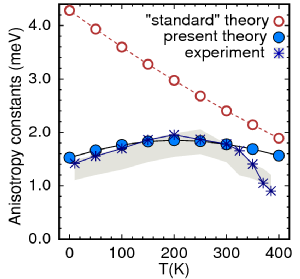Calculating the Magnetic Anisotropy of Rare-Earth-Transition-Metal Ferrimagnets
Our work investigating the temperature dependence of the magnetocrystalline anisotropy of the RE-TM magnets YCo5 and GdCo5 has been published in Physical Review Letters.

Permanent magnets, like those found inside hybrid car motors, often have to operate in challenging conditions. Having a large "magnetic anisotropy" - which means magnetic materials prefer to have their magnetic moments pointing along certain directions - can help the magnet to keep working effectively even when subjected to high temperatures or strong magnetic fields. One way of engineering this anisotropy is to change the shape of the magnet, e.g. shaping the magnet into a horseshoe, but a much more effective way is to change its chemical composition. Specifically, combining rare-earth (RE) elements (particularly Sm, Nd and Dy) with transition metals (TM; Fe and Co) can generate huge magnetocrystalline anisotropy (MCA) whose origin is a complicated interplay of special relativity and quantum mechanics. In this work we show how a standard approach of calculating the MCA is not sufficient when trying to understand ferrimagnets, i.e. magnetic materials which contain a number of different magnetic elements, such as the RE-TM magnets. Instead, we have developed a new theory in which we directly simulate the experiments used to measure the MCA. We demonstrate the new theory by comparing its results to experimental measurements made on a single crystal of GdCo5 grown at Warwick.
Journal reference:
